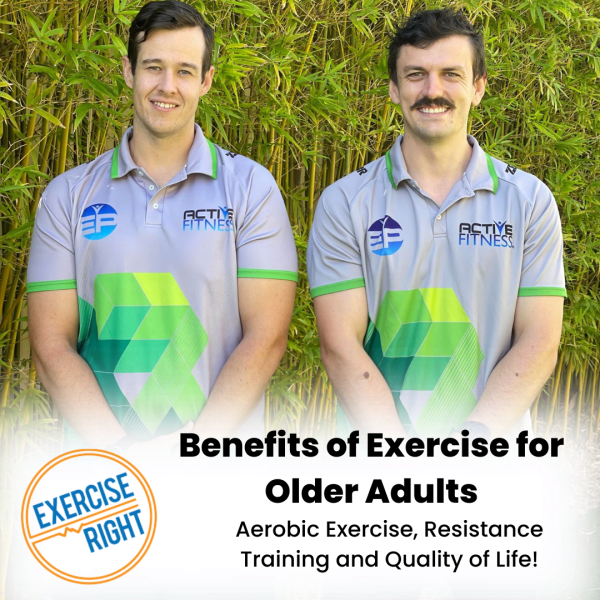As we get older, physiologic changes that limit function and general quality of life occur at a faster rate. Sedentary behaviour increases with age making older adults the most sedentary, and currently 75% of Australians aged 65 and over are not sufficiently active (1). This lack of physical activity has negative effects on cardio-metabolic health, muscle-tendon health, functional fitness, physical independence, body composition, and all-cause mortality (2).
Aerobic Exercise
Aerobic exercise training refers to exercises in which the large muscles of the body move in a rhythmic manner for sustained periods of time. Examples of aerobic exercises include walking, swimming, cycling, stair climbing, etc.
Benefits include:
– Decreased cardiovascular risk factors
– Lower heart rate at rest and during low intensity exercise
– Improvements in blood pressure
– Decreases in blood glucose levels
– Improved whole-body insulin action
– Reduction in circulating cholesterol (2)
Resistance Training
Sarcopenia is the loss of muscle mass due to the natural aging process. Sarcopenia in the elderly population has been associated with poor functionality, frailty, and disability. Strengthening or resistance exercise training is an effective method to counteract the age-related changes of sarcopenia.
Benefits include:
– Increased lean muscle mass
– Increased strength
– Preserved/increased bone mineral density and joint health
– Reduced risk and symptoms of some chronic diseases
– Reduce symptoms of pain (1)
Lastly, aquatic exercises provide natural resistance from water but also take the load off osteoarthritic joints and bones (2).
Quality of Life
Older adults are at a higher risk of falls, cognitive decline and chronic illness. Regular aerobic, resistance and balance exercise has been shown to:
– Improve sleep quality
– Increase social engagement
– Reduce feelings of loneliness
– Slow cognitive decline and the incidence of dementia
– Preserve/enhance memory
– Increase blood circulation to the brain
– Improve mental health conditions such as anxiety, depression and stress (1,2)
For more information on the benefits of exercise for Older Adults follow the link below. https://exerciseright.com.au/wp-content/uploads/2020/05/ESSA-Exercise-for-Older-Adults-eBook_2020.pdf
Those looking to begin a regular exercise routine should speak with their GP or our exercise physiologists here at Active Fitness HQ. Those looking for a social and fun way to get back into exercise should consider joining our group classes for older adults, Fit To Be and/or Ageless.
References
1. Exercise & Sports Science Australia (ESSA). Exercise for Older Adults [Internet]. 2020 [cited 2023 May 18]. Available from: https://exerciseright.com.au/wp-content/uploads/2020/05/ESSA-Exercise-for-Older-Adults-eBook_2020.pdf
2. Galloza J, Castillo B, Micheo W. Benefits of exercise in the older population. Physical Medicine and Rehabilitation Clinics. 2017;28(4):659–69.



